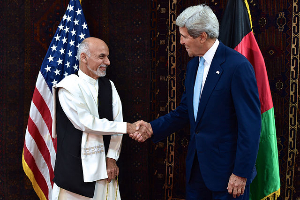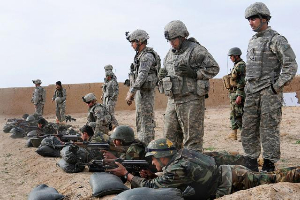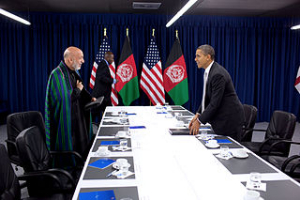Washington and Kabul Renew Their Security Commitments
By Richard Weitz (11/26/2014 issue of the CACI Analyst)
The Afghan parliament has authorized the continued deployment of thousands of U.S. and NATO forces in their country next year. Due to the opportunity offered by a more friendly Afghan government and the challenge presented by a declining regional security situation, the U.S. military will continue to provide some combat support for the Afghan Army. Meanwhile, China, which is experiencing an upsurge in Islamist terrorism, has been raising its economic and diplomatic profile in the country.

Russia Concerned Over Tajik-Afghan Border Security
By Oleg Salimov (11/11/2014 issue of the CACI Analyst)
Representatives of Afghanistan took part in parliamentary assembly meeting of the Collective Security Treaty Organization (CSTO) in Moscow on November 6. The assembly identified as priorities the threats of terrorism, extremism, and drug trafficking in Afghanistan and neighboring Central Asian countries. According to Tajikistan’s national information agency Khovar, similar questions were discussed during a recent meeting between Tajikistan’s President Emomali Rakhmon and the secretary of Russia’s Security Council Nikolai Patrushev on October 16 in Dushanbe.
As reported by opposition and independent media in Tajikistan, the meeting was held behind closed doors with only a few reporters of a state-sponsored news agency present. The later issued statement for the press accentuated Tajik-Afghan border security, the perspectives of Russian-Tajik military cooperation, and informational security. Other participants of the meeting in Dushanbe included representatives of Russia’s Ministry of Foreign Affairs, Ministry of Defense, and Federal Security Bureau. The meeting in Dushanbe and the following CSTO meeting in Moscow were rounded up by Russian President Vladimir Putin’s announcement of Russia’s willingness to assist the Afghan government in its efforts to restore peace and security in the country.
The conclusion of the active part of the military operation in Afghanistan and the long planned withdrawal of International Security Assistance Forces in 2014 has triggered active consultations among Central Asian countries, Russia, and China in the CSTO and SCO formats. Possessing the longest border with Afghanistan among the Central Asian republics, which stretches through inaccessible mountainous regions, Tajikistan is the most vulnerable to security threats if the situation in Afghanistan deteriorates. Other complicating factors include Tajikistan’s fragile political stability, the inability of Tajikistan’s military to control the Tajik-Afghan border, and the threats of homegrown Islamic radicals.
Hizb ut-Tahrir is considered by the Tajik government as the main extremist organization spreading the ideas of radical Islam in Tajikistan. The organization confesses to a salafist-wahhabist ideology, possesses strong ties with radicals in Afghanistan and Pakistan, and propagandizes the creation of a worldwide Islamic caliphate. The other extremist organization is the Islamic Movement of Uzbekistan located primarily on the territory of Afghanistan and having numerous supporters in Tajikistan, Uzbekistan, and Kyrgyzstan. The predecessors of the IMU, founded in 1998, were fighting on the side of Islamic opposition during the Tajik Civil War and also took part in Commander Makhmud Khudoberdiev’s attack on Northern Tajikistan in November 1998.
A number of Tajiks are also currently fighting for ISIS in Iraq and Syria and concerns are growing that their return could coincide with a potential restoration of Taliban power in Afghanistan and facilitate coordinated attacks on both sides of the Tajik-Afghan border. According to Tajik state media, five Tajiks were convicted in Tajikistan on charges of terrorism upon return from Syria earlier this year and Tajik officials issued condemnation after reports of a Tajik citizen being appointed by ISIS as the head of Ar-Raqqah in Syria after the fall of the city. While radicalization previously mainly affected Tajikistan’s southern regions, observers report a growing number of Islamic radicals in Northern Tajikistan according to Radio Ozodi.
The problem is multiplied by the Tajik government’s inability to fully control the Autonomous Badakhshan region which borders Afghanistan. Badakhshan became a hideout area for irreconcilable post-Civil war militants and a hotbed of radical Islam. Rakhmon ordered several military operations in Badakhshan after terrorist attacks on Tajik government officials in 2010 and 2012. The military actions had little to no effect in improving security in the region. The nominal government control implies higher penetration of the border by extremists and drug traffickers, the Tajik government’s neglect of which is frequently highlighted by local independent media. Tajikistan is the second largest source of northward trafficking of Afghan heroin after Iran.
The situation deteriorated after the withdrawal of a Russian border patrol contingent in 2005. While Russia continued to maintain an Operational Border Group in Tajikistan after 2005, the recent border cooperation agreement signed in September 2014 foresees the reduction of this group from 350 to 200 specialists and duties void of operational actions to consultation “on request” only. Drug trafficking and the spread of extremists to its southern and predominantly Muslim regions were constant concerns of the Russian government and one of the main arguments for its military presence on the Tajik-Afghan border. This consideration has motivated a proposal of Russian technical military assistance to Tajikistan of up to US$ 200 million until 2025.
The visit of Nikolai Patrushev to Dushanbe and the following security meeting in Moscow demonstrates Russia’s determination to step in after ISAF’s withdrawal from Afghanistan. There has so far been no official reaction from Tajikistan and other Central Asian countries, including Afghanistan, on these perspectives and Vladimir Putin’s announcement.
Afghan Peace Hopes Amid Green-on-Blue Attacks
By Naveed Ahmad (10/15/2014 issue of the CACI Analyst)
On August 5, an Afghan in army uniform opened indiscriminate fire, killing a U.S. army major general besides wounding 15 coalition troops. One German brigadier general and two Afghan generals received non-fatal bullet injuries. Green-on-blue attacks are the most alarming trend in Afghanistan, which has forced ISAF to instruct each soldier to carry a loaded weapon when amongst Afghans. The most recent attack casts a serious shadow over Afghanistan’s stability after NATO hands over internal and external security to Afghan security forces. Even the unprecedented news of two opposing presidential candidates reaching a power-sharing deal offers little hope.

Afghan Political Settlement Unlikely Before the U.S. Exit
By Mushtaq A. Kaw (09/17/2014 issue of the CACI Analyst)
Alongside the current U.S.-Taliban conflict, the U.S. has unsuccessfully sought reconciliation with the Taliban for a political settlement of the Afghan crisis. Nonetheless, in May 2014, the U.S. swapped five Taliban prisoners for one U.S. soldier to renew the peace process and ensure stability in Afghanistan before the planned exit later this year. However, the prisoner exchange failed to deliver results due to the Taliban’s indifference to dialogue and democratic processes. Consequently, no political settlement for peace in Afghanistan is forthcoming before the U.S. drawdown. A settlement is equally unlikely in its immediate aftermath, which will likely be dominated by rivalries between the Taliban and their competitors.

China and Afghanistan – Time of Decision
By Richard Weitz (09/03/2014 issue of the CACI Analyst)
President Barack Obama’s recent characterization of China as a global free rider certainly applies in Afghanistan. Although China has declined to join the NATO-led International Security Force in Afghanistan or even allow its members to use Chinese territory to supply their forces in Afghanistan, Chinese firms have been benefiting from the massive economic and security contributions of other countries to Afghanistan. But that time is ending and China and the West need to strike a new and more balanced bargain there. Chinese alarm about Afghanistan is rising as U.S. concerns and commitments are declining.






